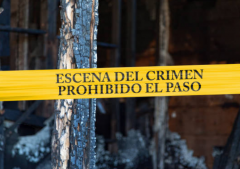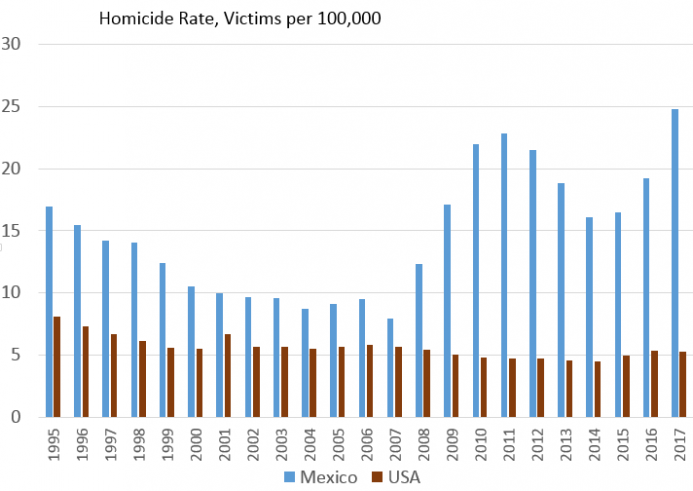Authored by Ryan McMaken via The Mises Institute,
The Mexican government, which has contributed heavily to Mexico having one of the world’s worst homicide rates, has announced it may seek legal action against the United States “for failing to protect its citizens after this weekend’s mass shooting in the border city of El Paso.”
In a statement yesterday, Foreign Minister Marcelo Ebrard stated
The president has instructed me to ensure that Mexico’s indignation translates into … efficient, prompt, expeditious and forceful legal actions for Mexico to take a role and demand that conditions are established that protect … Mexicans in the United States.
Yet, it’s hard to believe that Mexican politicians are truly indignant about the deaths of Mexican nationals in the US when Mexico’s homicide rate is nearly five times that of the US, and among the worst in the world. Moreover, Mexico’s homicide rate in 2017 rose to the highest level ever recorded, climbing to 24.8 per 100,000 . Preliminary data suggests 2018 may be even worse .
More than 30,000 homicide investigations were opened in Mexico in 2017. In the US, which has 200 million more residents than Mexico, homicides total around 17,000.
These fact, however, have not stopped the Mexican state from displaying a total lack of self-awareness when it comes to crime and safety.
The foreign minister also implied the US was at fault due to faulty gun laws:
Ebrard said Mexico would request information from the U.S. about how the weapon used in the attack was acquired by the shooter.
“We consider the issue of arms to be crucial,” he added.
As with homicides overall, it’s hard to believe that Mexican politicians are sincere when expressing indignation about the manner in which Americans acquire firearms.
Gun control is stringent in Mexico, which means illegal gun ownership is widespread, and law-abiding citizens are lopsidedly outgunned by drug cartel members and ordinary street thugs.
The Mexican government — and gun control advocates in the US — have attempted to distract from these fact by claiming the US is somehow responsible for the presence of illegal guns in Mexico, but the evidence hasn’t backed this up.
Trying to Blame Mexican Violence on US Guns
The often-quoted statistic allegedly showing that as much as 70 percent, or even 90 percent, of guns seized in Mexico come from the US is not true. That statistic is based only on seized guns that are also traced by the ATF . How many of all guns seized in Mexico come from the US? According to Stratfor, ” almost 90 percent of the guns seized in Mexico in 2008 were not traced back to the United States .” Nor does the Mexican government ask the ATF to trace all guns seized in Mexico. This is because many of those arms can be traced back to the Mexican government itself.
After all, it’s not as if Latin America has no locally produced firearms. The 2012 Small Arms Survey notes:
Latin America has a long tradition of gun production, with some manufacturers tracing their history back many decades. Brazil has the largest arms industry in the region, followed by Argentina. Firearms are also produced by private or government-owned industries in Bolivia, Chile, Colombia, Ecuador, Mexico, Paraguay, Peru, and Venezuela. While most of the production is intended to equip the military and law enforcement institutions, some of the production is for private use.”
The report also refers to “major exporters” of small arms in Argentina, Chile, Mexico, and Brazil. So we know Mexico contains local arms-producing manufacturers to the point that some are “major exporters” who also produce arms for government institutions. And government stockpiles are a source for black markets as well.
Even worse, the same government institutions that work to keep firearms out of the hands of peaceful private citizens, are often in league with the cartels. As a recent New York Times article noted about local resistance in Michoacan to cartel-sown chaos, “Townspeople formed militias to eject both the cartel … and the local police, who were seen as complicit.”
In other words, there is often no clear line between law enforcement and the cartels themselves.
Often, official law enforcement simply can’t be bothered . Things are even worse when, as one cartel member put it, “soldiers and cops are … really on our side.”
Thus, it shouldn’t exactly be a surprise that many of the guns seized in Mexico are coming from official government sources.
Of course, even if it were true that Mexican criminals were getting their guns from the US, how is it that crime wave only goes one way? If guns are the reason for high crime in Mexico — where guns are hard to legally acquire — shouldn’t crime rates be far higher in the US where guns are far easier to get?
It can’t be that Mexico has implemented a drug war. The US wages a drug war too.
Nor can we even fall back on some sort of article about Mexican race or culture. Many US border towns, which are heavily Mexican American in origin are some of the safest places in the US. El Paso, for instance, which is more than 80 percent Hispanic — has long been one of the safest cities of its size in America. Homicide is so rare in El Paso, in fact, with only 20 homicides in 2017, that the El Paso shooter more or less doubled the homicide rate in that city in a few minutes.
Mexican-Style Reforms: More Gun Control and More Centralization of Power
Thus, when Mexican politicians hint that the US is not sufficiently protecting Mexican nationals, it’s hard to imagine which Mexican officials think would be the proper course of action. Should US governments adopt Mexico style legislation?
Given the complete failure of Mexico’s gun-control regime, one would hope not.
Moreover, centralization of government power in Mexico has helped ensure local and state governments in Mexico are unable to address problems on their own.
Although the Mexican political system is technically a federal system, the reality is far different, since the central government tightly controls the overwhelming majority of tax revenues.
Indeed, the federal government has maintained the lion’s share of control of government funding. As The Economist noted in 2003 , most government revenue, including all levels of government, flows to the federal level alone:
Power may be dispersed, but money is not. About 80% of federal revenues are appropriated by the centre; most of the rest falls to the states, though 5% is spent by the municipalities. In Brazil, by contrast, the federal government controls only around half of total government revenues.
Under Mexico’s law of “fiscal co-ordination”, the states’ powers to raise local revenues are restricted. They consist chiefly of fairly small taxes on payrolls and on cars; municipalities must rely on symbolic property taxes. At one extreme, the Federal District, the quasi-state which includes much of Mexico City, raises about 45% of its $8 billion budget itself. Most states are at the other extreme—lucky if they gather 10% of their spending.
For the other 90%, they must rely on federal transfers, divided up under a notoriously complicated formula dating from 1980.
The situation had not changed markedly by 2018 with Robert Velasco-Alvarez noting :
According to Moody’s , the average Mexican state collects only 10 percent of its income. The other 90 percent of the states’ budgets comes in the form of federal government transfers. 3 A former head of our secretary of the Treasury’s Unit for Coordination with the States claims that municipalities account for only 1.1 percent of Mexico’s tax revenues.
By contrast, in the United States, state and local tax collection — while certainly less than that of federal receipts — amounts to over forty percent the size of federal revenues. In numerous states, state revenues alone— not counting local revenues — reach thirty percent the size of federal revenues. When we look at federal aid to states as a percentage of state revenues, we find that rarely does federal spending amount to more than 35 percent of state revenues.
In other words, states in Mexico are considerably more reliant on federal spending than is the case in the US. This means more central planning and more nationwide corruption. It’s perhaps no surprise that after 20 years of top-down solutions to the crime problem in Mexico, homicide rates are higher than ever.
So one could imagine the Mexican politician’s version of reform: implement gun control, and centralize political power.
We can see the result of this system at work in Mexico right now.
I don’t say any of this, of course, to try and make governments in the US look blameless or competent. American politicians are certainly not strangers to gun control or corruption, especially in places like Baltimore where homicide is rampant.
Moreover, the US has long made the drug war worse in Mexico by pressuring the Mexican government to abandon efforts to de-criminalize or legalize some recreational drugs. It has long been the policy of the US to use Latin American communities as the battlegrounds in the US’s drug war. With disastrous results for the Latin Americans.
But Mexico’s current posturing and grandstanding over the murders of Mexican nationals in El Paso would be comical if the shooting weren’t tragic. Listening to Mexican officials berate a foreign government about homicides is like listening to the US government lecture other governments about the need to respect the sovereignty of foreign states. It’s just politicians talking and ought to be ignored.
via ZeroHedge News https://ift.tt/2T9lUSE Tyler Durden

